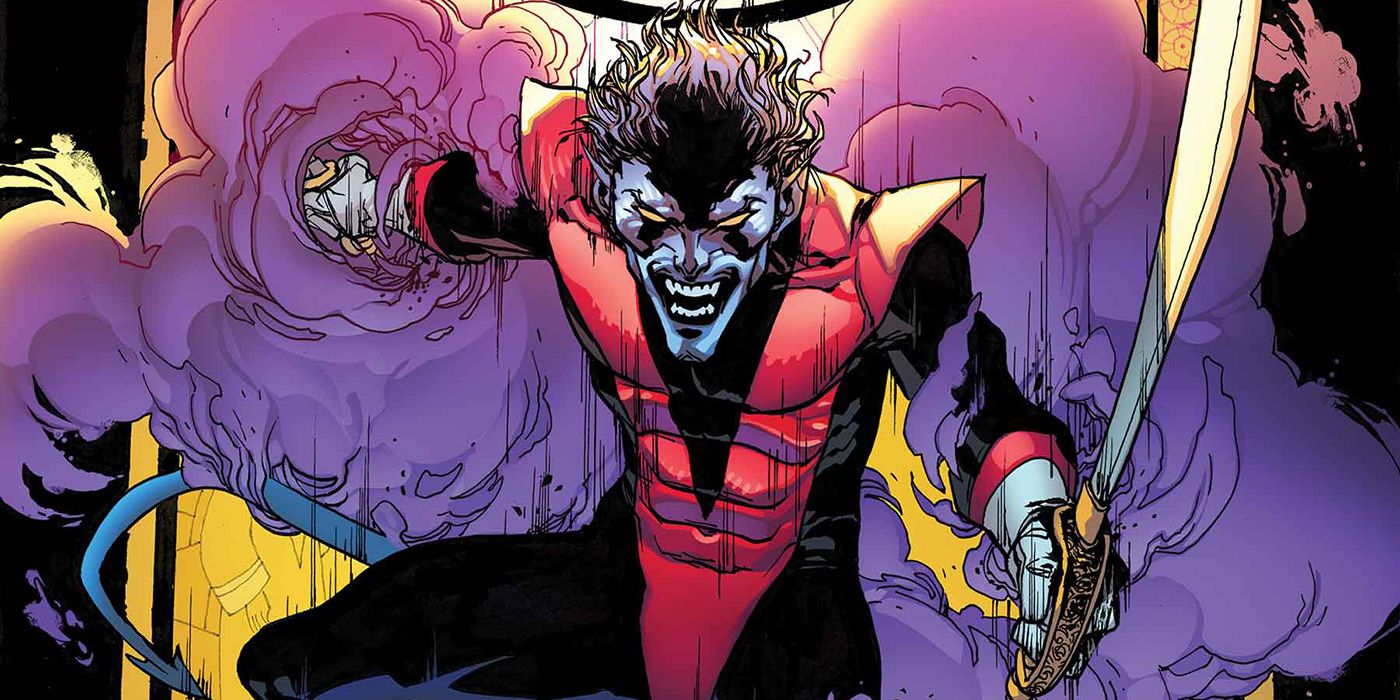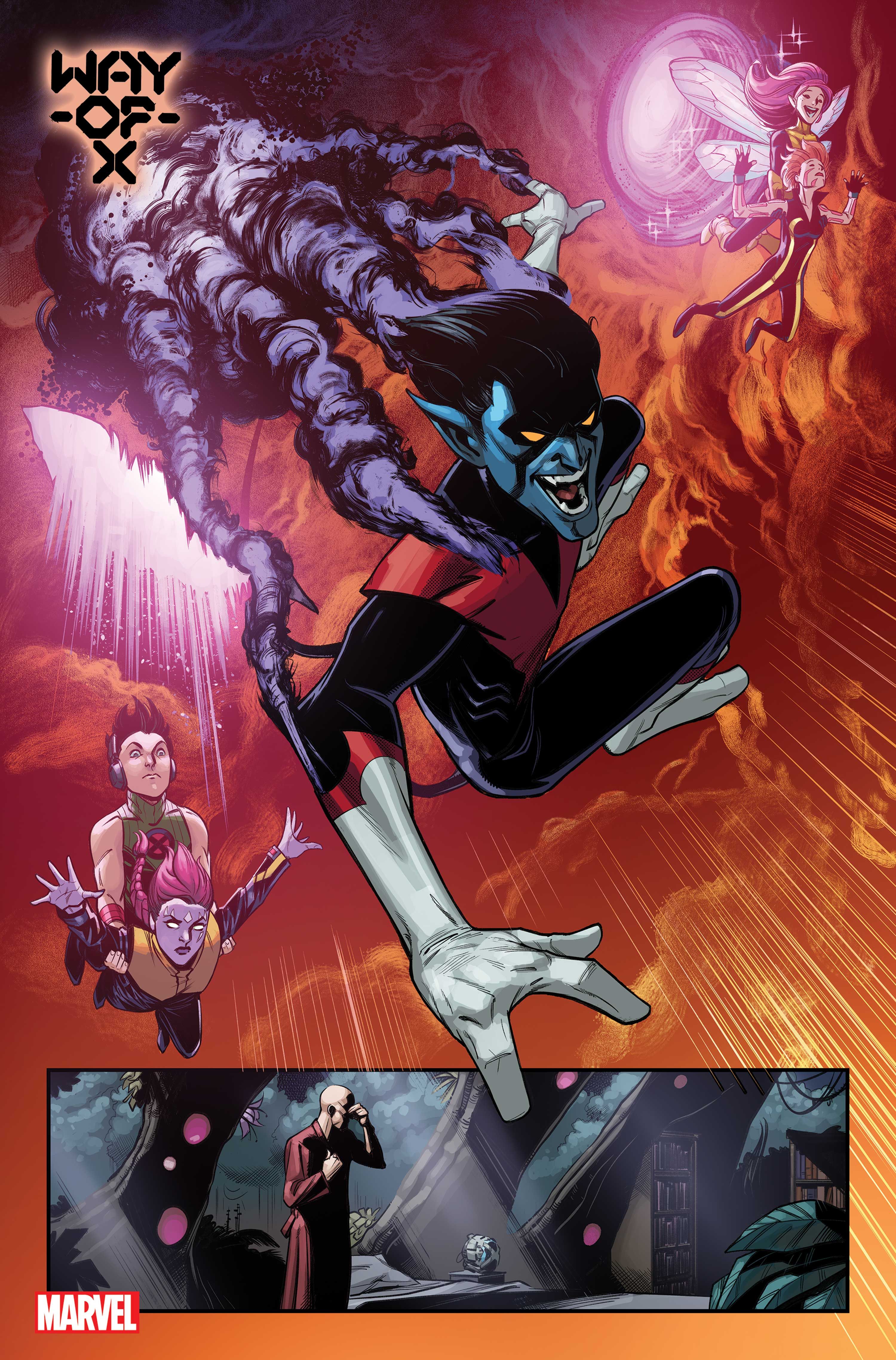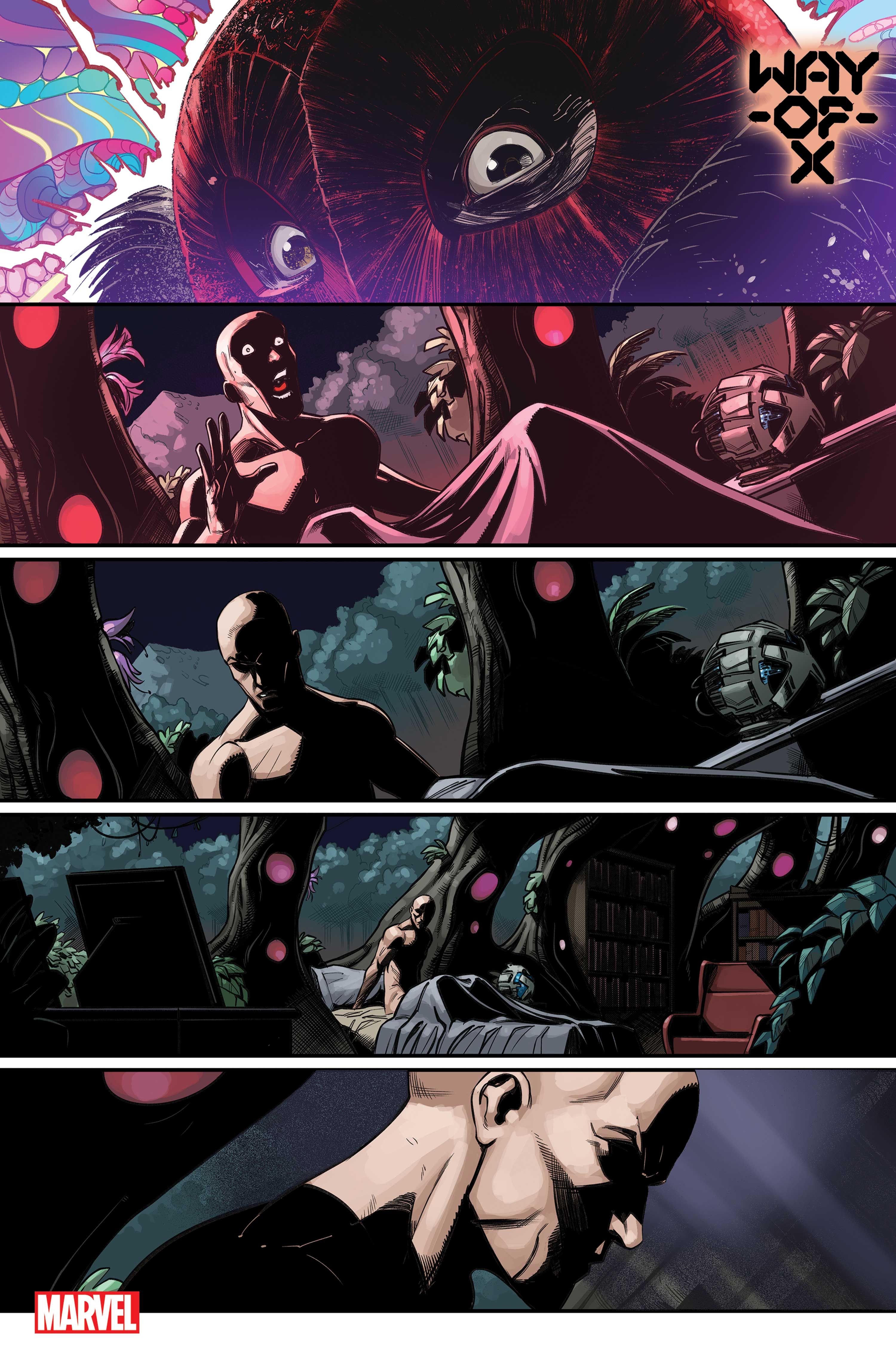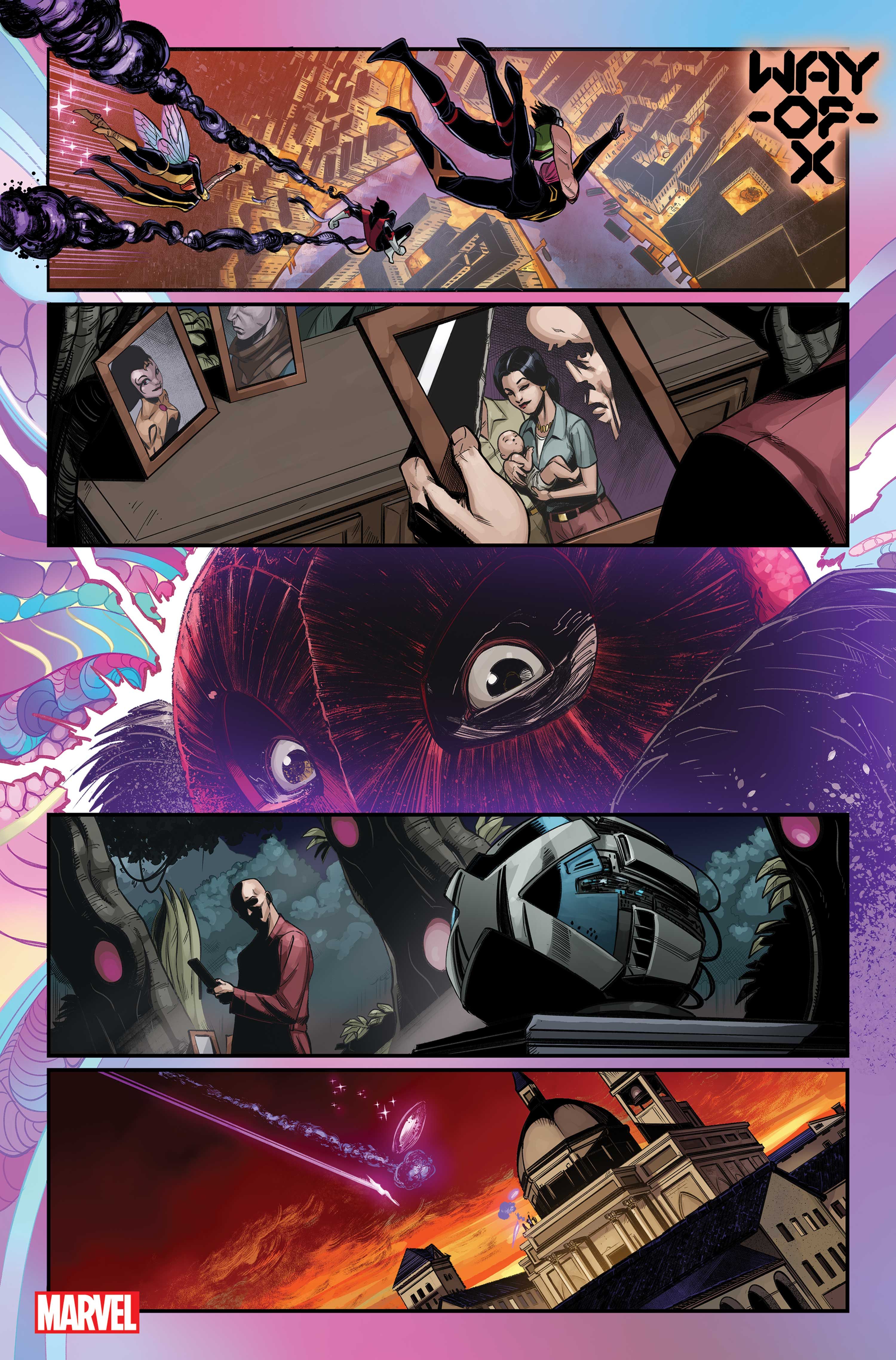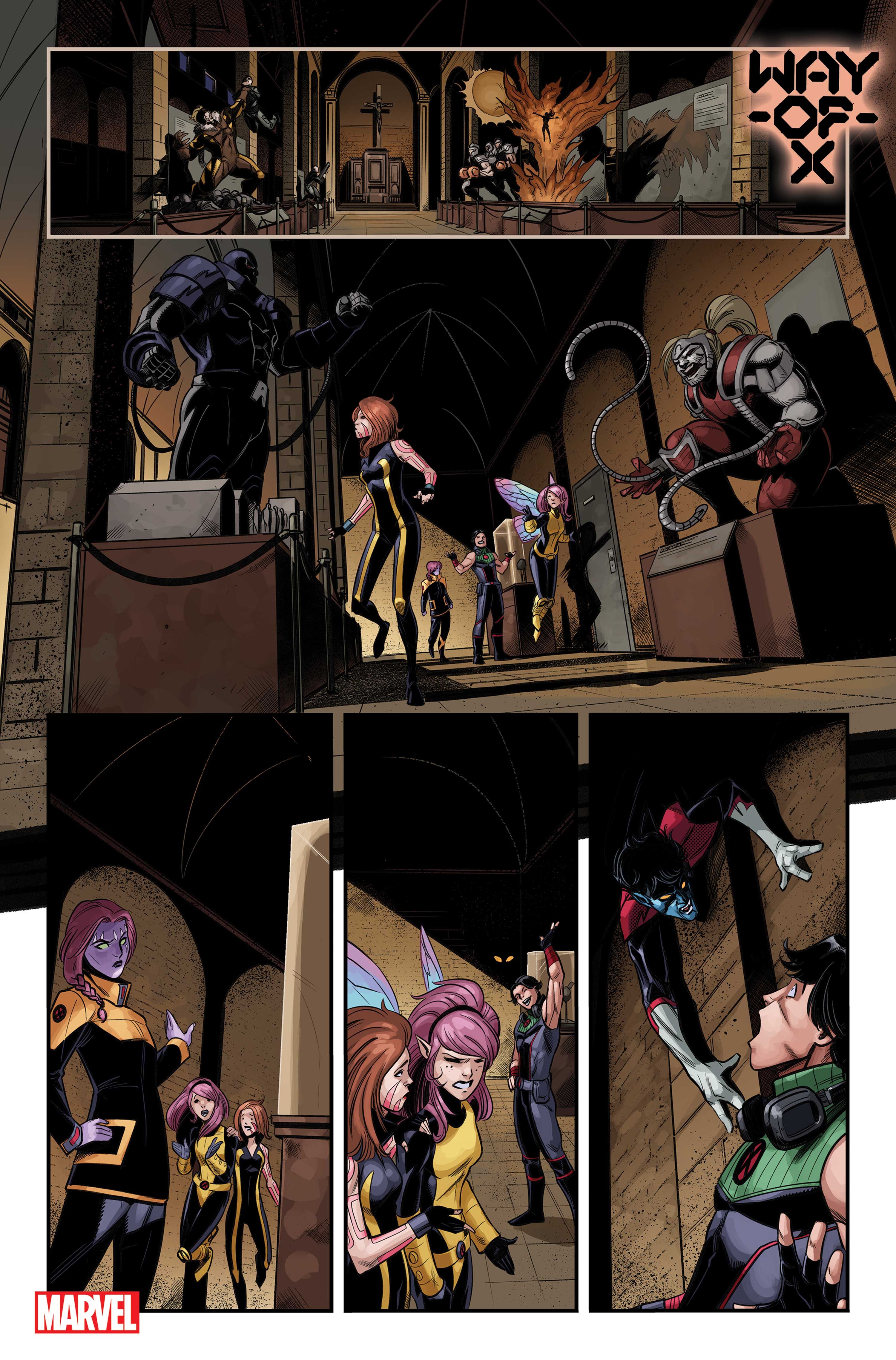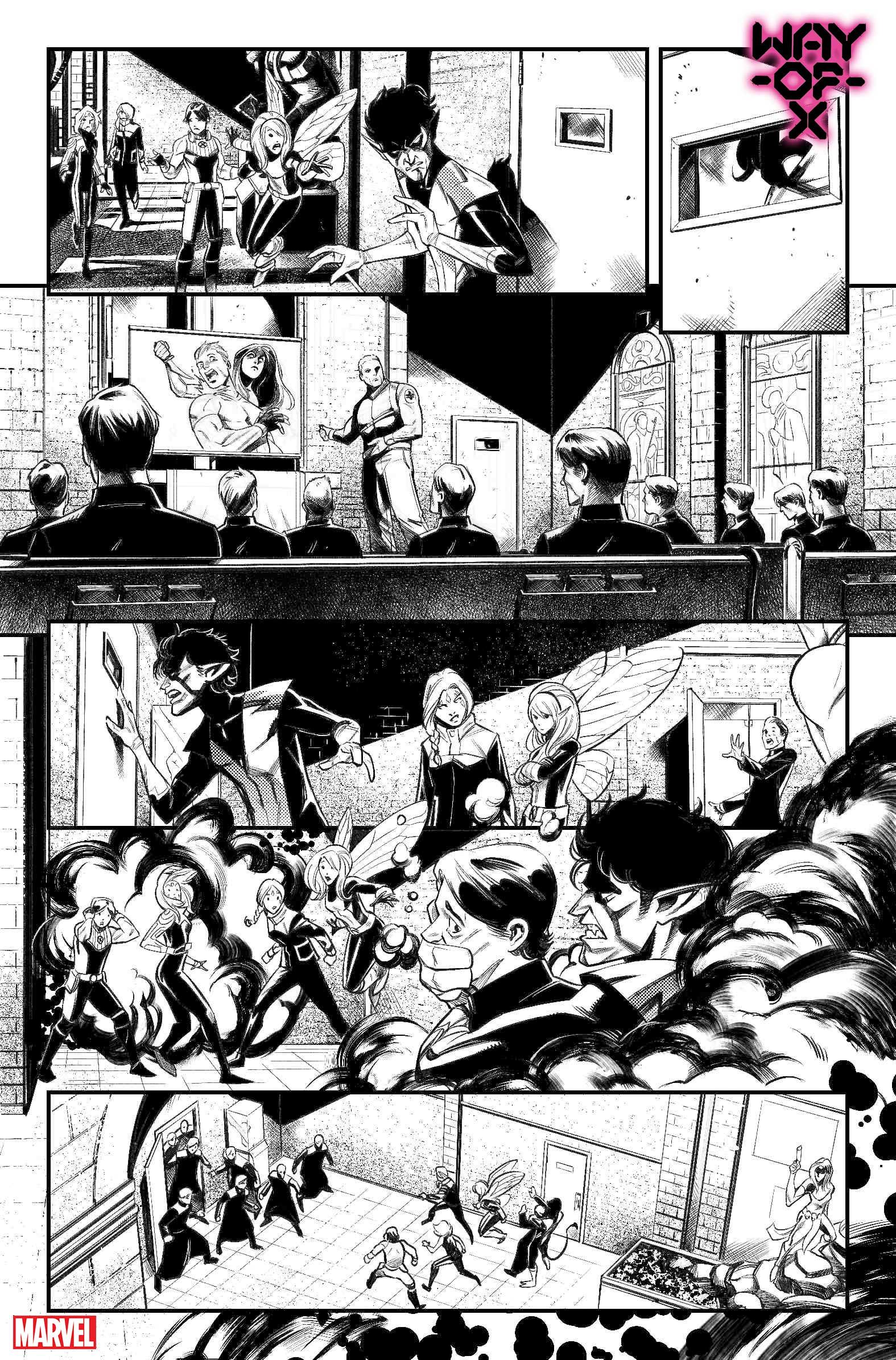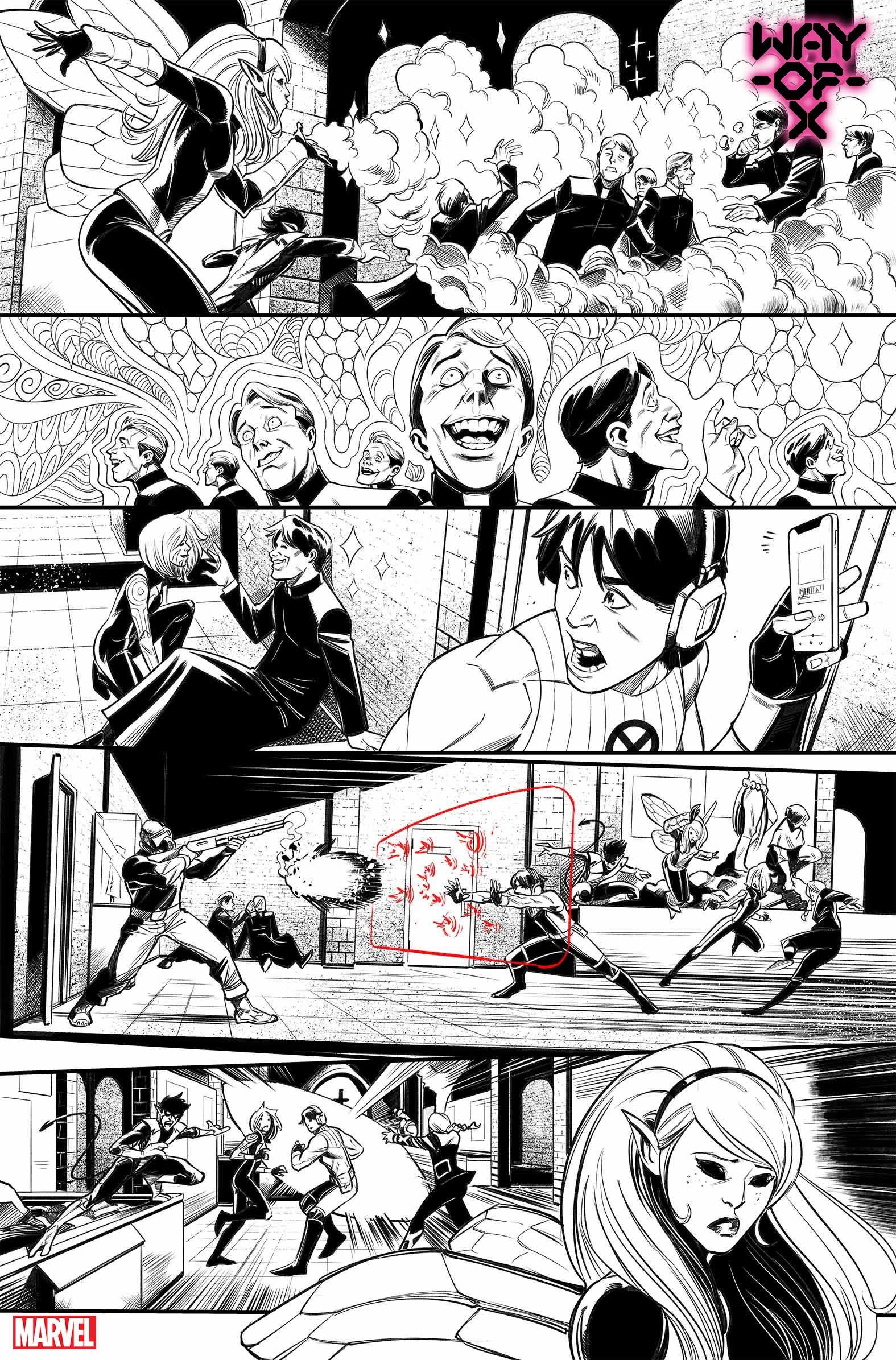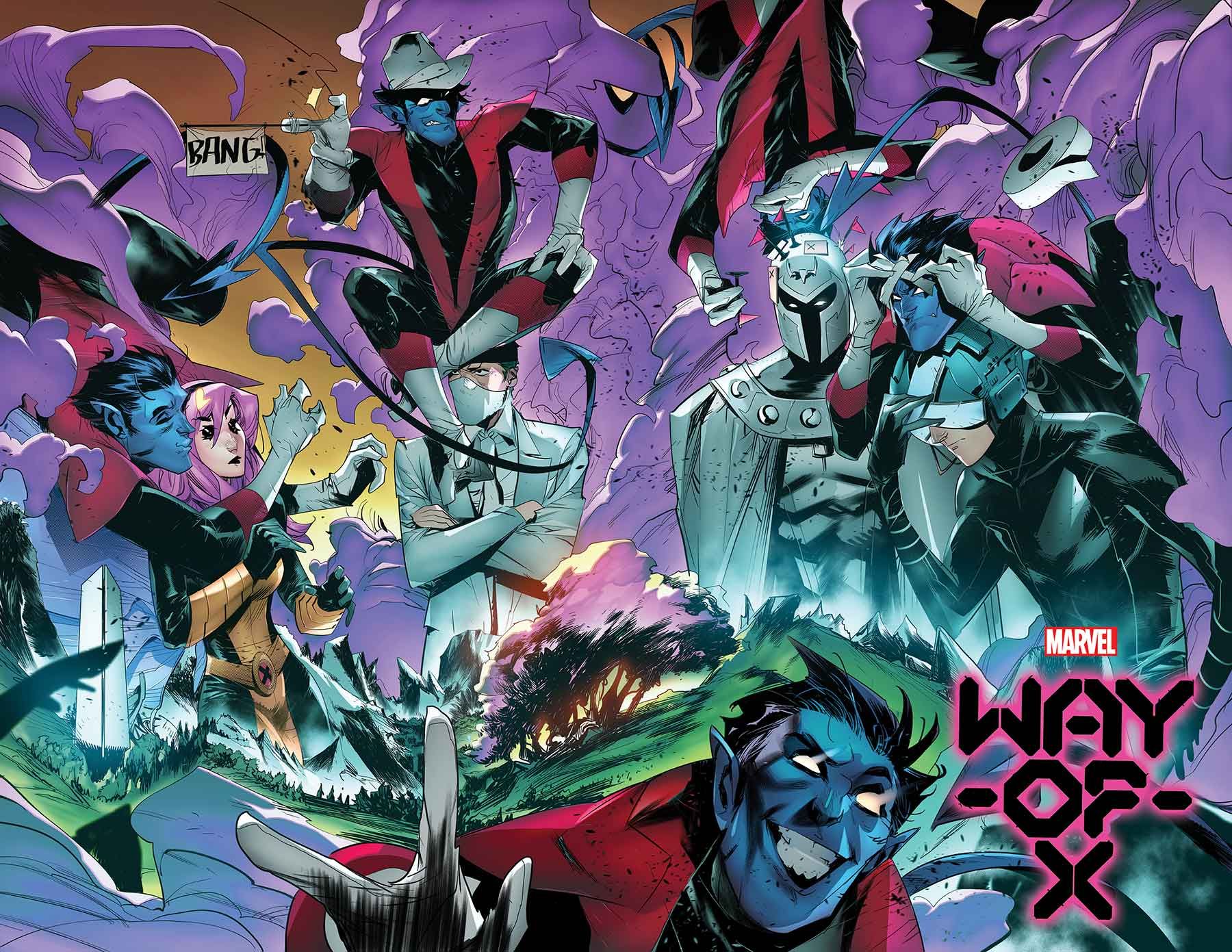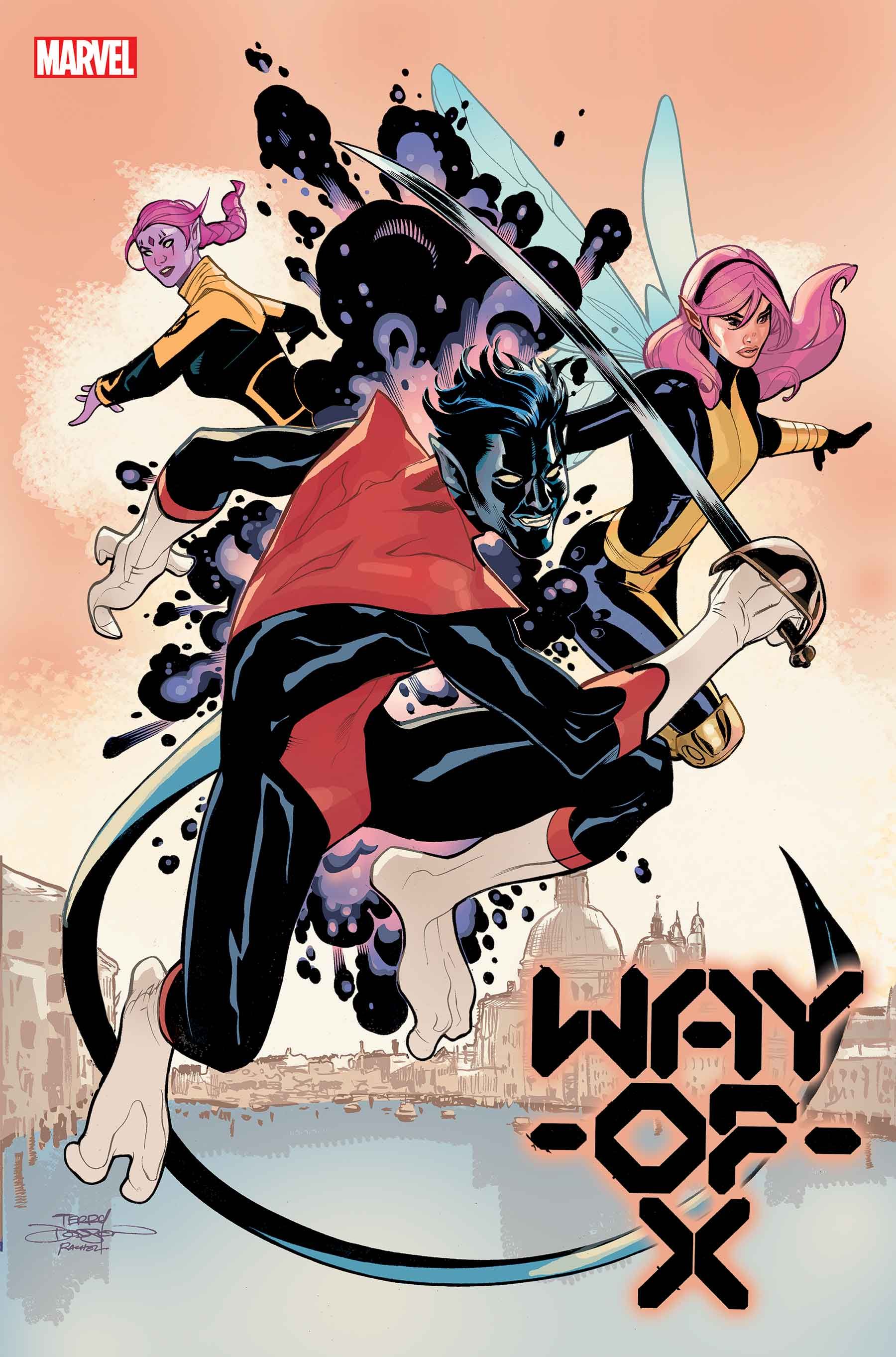As a member of the X-Men, Nightcrawler fights to protect the physical wellbeing of the mutants of Krakoa, but as a man of faith, he's always taken an interest in their spiritual and emotional welfare too. In the light of that roll, Kurt Wagner has grown increasingly uneasy with certain aspects of the mutant nation Krakoa, such as its status as a global superpower, and its secret conquering of death itself via a combination of powers that can resurrect fallen mutants. Kurt’s concerns will put him in a position to uncover an invisible threat that has burrowed into the heart of the life that mutants have carved out for themselves on Krakoa.
That threat is uncovered in April's Way of X #1, the kickoff to a brand new ongoing series by writer Simon Spurrier and artist Bob Quinn that sends Nightcrawler and his allies on a physical, spiritual and psychedelic quest to save their home. CBR spoke with Spurrier about his take on Nightcrawler, the book's supporting cast, and how the series is just as much a heady and weird exploration of faith and philosophy as it is a fun, sci-fi action series. We've also got a look at some pages from the series by Quinn and colorist Java Tartaglia, along with variant covers by Terry Dodson and Federico Vincentini.
CBR: Nightcrawler is a character with a number of fascinating traits. Which facets of the character do you find most intriguing?
Simon Spurrier: Above all? He has an endless capacity to be conflicted. When you think about Nightcrawler you might think of a mischievous trickster with an outsider’s sense of humor, but you’d also have to think of an ordained Catholic priest. Somewhere amidst all the different hats he wears, he’s become troubled by the stuff that's been going on in Krakoa. Since the Dawn of X, the mutant race has created a global superpower, based on the leverage that comes from physical clout, political know-how and incredible scientific discoveries. For mutantkind, sickness and death have been overthrown.
That's a world that gets my all hard sci-fi senses buzzing. And when you smash all those big beautiful sciencey ideas with the far less sciencey things that lurk in the human heart -- emotion, sentiment, faith, superstition -- well, that’s a fertile car crash for stories to come spilling out.
So here’s Nightcrawler, living on an island inhabited by thousands of young and beautiful people, where there's no sickness and no death, no clear moral compass, no reason not to try new things, be they beautiful or brutal. You can easily imagine he’s going to frequently encounter sights which would make a Catholic Priest fume. Or blush. Or both. [Laughs]
Right, isn't one of the nation's edicts, “Make more mutants?"
Exactly! And we'll come to that. The point is, it's no surprise that Kurt is troubled. He has lots of questions about how this whole thing is supposed to work. He’s this poor fool who desperately wants to fit in and enjoy himself, but he’s wandering about saying, That's wrong!” Except when someone asks why it’s wrong, he has no answer. In this new world, there are no limits and nothing is quite the same as it was in the homo sapiens' world. The old codes and morals don’t apply in quite the same way. The erasure of mortality, the commonality of possessions, the mitigation of sickness - when you start from that position you quickly realize a lot of the laws and commandments that guide the Western world don’t entirely fit anymore. What Kurt takes to be instinctively wrong often isn’t. Or at least, can't be rationally described as such. That’s a problem because it turns out there really is something desperately ugly lurking under the surface. The emerging culture of “anything goes” makes it extraordinarily difficult to find and fight.
You might remember in X-Men #7, Jon [Jonathan Hickman] wrote Nightcrawler revealing that he has a lot of questions about Krakoa and the society that’s developing. It ends with him saying, “I think I need to create a mutant religion.”
It's a bit too simple to say that's what Way of X is about, but... that's what it's about. [Laughs] That’s its cue, anyway. It’s a springboard.
This is a book about Nightcrawler sensing that there’s a need in Krakoa which nobody else has spotted. And before he can satisfy that need, he has to figure out exactly what it is and how bad things will get if he fails. His journey doesn't take him where he thought it would. It certainly doesn't take him to a place where he sits down to create a new mutant religion with a god, priests and prayers, because that's not what this problem needs.
What can you tell us about the nature of this problem?
Something has slithered into a gap in the mutant community. This evil thing has identified that if you are part of a society that has no limits then you also have no direction. Look, there's a whole heap of anthropological and sociological stuff that I could bore you with here, to hint at the big picture and foreshadow some of the fears and doubts Nightcrawler is sensing on the horizon, but this is comics! So, luckily for us, all this high-falutin’ stuff takes a very familiar, and utterly terrifying, form. It’s an individual who is lurking in the shadows, exacerbating the risks that arise when you have a society without any rudder or anchor. Especially when that society is made up of people with superpowers. It’s the sociological equivalent of a nuke, and this thing, this threat, has its finger on the button.
So, Nightcrawler and his slowly building band of allies struggle to figure out what they need to be in order to keep Krakoa functioning. Do they need to become cops? Do they need to be confessors? Or executioners? And the answer is kind of all of those things -- and none. They need to be something totally new.
Underneath all this is a good old fashioned X-Men romp about some really awesome characters identifying a threat and figuring out what they have to do to beat it. What we end up with is a book that's thoughtful, psychedelic, funny, mischievous, silly and sexy.
There are four other mutants on the cover of Way of X #1; Pixie, D.J., Loa, and Blink. Are these characters Nightcrawler's allies or apostles?
This isn't exactly a book with a core team. At least, not at first. We’re on a journey of discovery with Kurt, and part of that comes from his gradual accrual of experts, allies and mentors. That said, in as much as we are sort of heading towards some manner of team, Pixie will certainly be part of it.
Those other characters are present in various ways and roles along the way. Often simply because they’re friends with Pixie and other relevant players. It helps to think of WoX more as an ensemble of interconnected lives rather than a unit or corps from the get-go. We first encounter these particular youngsters in the opening sequence of Issue #1. It’s this incredible stealth mission to infiltrate a Catholic church in Venice, which is suspected of having ties to the Orchis Protocol (one of the institutional Big Bads in this new Krakoan era.) We open with Nightcrawler, Pixie, Blink, Loa and DJ performing the mutant version of a H.A.L.O. (High Altitude Low Opening) jump. They're just falling out of the sky, using portals to direct and slow their approach. Bamf! Blink! Poff! It's this wonderful spectacle, and these kids are just enjoying the hell out of it. They can’t die, so why wouldn’t they take risks?
And then when things go sour inside the church we start to see a darker aspect to that same danger-loving culture. Without spoiling things too much, we’re floating the notion that death has become almost a thrill for the youngsters of Krakoa. It's a twisted stand-in for the somewhat sleazy peer-pressure kids can face to lose their virginity. They're saying, “Oh, you haven't died yet? Come on! Everybody's doing it...”
Needless to say, here's poor old Nightcrawler in the middle of it, going, “WHAT? This is so wrong!” But when they ask him why, he can’t put into words any rational or moral reason why it's wrong. If someone dies, they come back. No biggie, right?
Well, that's the sort of thing he's grappling with. Because it turns out it is a biggie. And it’s linked to this horrible something-or-other lurking just below the surface, threatening to tear down everything.
So, in a lot of ways this book is about him reconciling his faith, which is very much a human one with the superpowered place he calls home
Very much so. What excites me about all this is that Jonathan and the other X-book writers are using the core metaphors on a scale and with an ambition that’s truly novel. Marvel’s mutants have been deployed as a narrative stand-in for stories about race, sexuality, gender and anything you care to name. When I did X-Men: Legacy all those years ago, we used it as a way of talking about mental health and self-control. I've just been itching to find the next iteration, the next level. Doing so in a slightly mischievous way -- a book about science and faith -- feels very right.
Because it's not just about mutant people now. It's about the mutants being a people. That's a much bigger canvas and a much bigger metaphor, especially in today's world. We swim in a sea of cultural and nationalistic ideas that affect us on an individual basis whilst also speaking to much bigger pictures and problems with the world. We all feel instinctively that we should own ourselves - that we should control and direct our own lives - and yet we also constantly strive to belong to something bigger in order to feel meaningful. It’s a fundamental bit of cognitive dissonance that lies at the heart of so many human problems.
Well, if you're a man like Kurt, who thought he had all of that stuff figured out, and then suddenly, he’s in this Eden-like paradise which challenges everything he took for granted and functions according to a totally different set of principles. And if THEN you discovered that it’s being undermined and corrupted by forces beyond your control, you're going to act fast to figure out what's going on, right? And you won’t stop until you know how to right the equilibrium.
Again, without going too far into it, there's a beat at the end of Issue #1 which changes everything. I think it’ll catch a lot of people off-guard. By the time we get to Issue #2, our main cast will be a lot more noteworthy, let’s put it that way...
One of the things we do quite quickly is to separate any of our philosophical pondering from Kurt's Catholic beliefs, or anyone else's beliefs. We have cast members of other faiths involved in this story, and it quite quickly becomes clear that there is no way that any single faith is going to solve the problem. It doesn't work like that. So, when we talk about the Way of X it's not a god, or a bible, or a prayer system. It's a pathway. It's more Tao than faith.
Earlier you mentioned an issue about the Krakoan law, “Make more mutants.” What can you tell us about that?
As part of this journey, we’ll examine each of the three laws that were created to define and regulate the mutant nation early on its creation. We're trying to dedicate an issue to each one. We'll see what Kurt can do when he really thinks about those laws, and see if they provide any means of fixing his current problem. To an extent, there’s a cop procedural vibe starting to emerge from the haze here. But if that’s the direction we go - and I’m neither confirming or denying anything here - it’ll be a cop show unlike any you’ve ever seen. [Laughs]
Anyway, I'm halfway through writing the “Make more mutants” issue. The working title is “The Joy of X.” [Laughs] I don't know if I'll get away with that. It’s a lot of fun, mixed with some crazy repercussions. It's the sort of lateral-thinking stuff that you can examine when you have a world that's been built so cleverly. You can start to dial into the granular stuff and see how it would all work if you were there on the ground. In other words, this isn’t just a heady book about religion and philosophy. It's also a hoot.
What does the unseen enemy lurking in the heart of Krakoa mean for its various institutions and the major characters that run them?
It’s not a straight-up find-a-baddie-and-kick-their-ass book. It's more like there are ideas in the shape of individuals who are gradually chipping away at the things the mutants thought they had.
So it's pretty psychedelic, sure. As much as I recognize hints of big, speculative 1970s sci-fi in the stuff that John, Gerry, Tini, and all the others are doing in their books, I make no bones about Way of X dipping its toes in a sort of acid-drenched, lysergic version of sci-fi. To give you just one example, we meet one of my favorite X-characters, who has changed considerably since we last met them, and is now growing psychedelic fungus out of their brain. [Laughs] That's where we start, and it’s all expansion and acceleration from there.
So, in addition to mind-bending fun Way of X is also an exploration of what life is actually like on Krakoa?
Yes. Mutants now have their own empire, but they're still learning how to walk. They haven't figured out what life should be like on a daily basis. They don't have much of a culture yet, but it keeps bubbling-up in strange and sometimes horrific ways. Like the Crucible ritual, in which people can choose to be killed in combat so they can be resurrected in a better form. It just drips with archaic mythological tropes -- The Golden Bough, Rex Nemorensis and all that. Those are just some of the many things Way of X is interested in.
I feel like this book is the next logical step in the X-expansion -- X-pansion? sorry -- because up till now, most of the stories that have been told have taken place around the edges of this new empire. They've been about attack, defense and exploration. Small groups of people having their own adventures and intrigues. What I felt was missing is, “What's it like to just live in this place? What sort of drama and terrors would be encountered on a daily basis?” What I discovered, when I spent some time thinking about that, is that if you're a council member or one of the big-name heroes, you're probably so busy doing the big world-shaking stuff that you wouldn't even recognize that there was something wrong in the layers of culture and community below it.
There a lot more weird and complicated strata to it than that, but yeah. This is why Nightcrawler is the only one who's figured it out. There's this lovely little scene in the first issue where he chats with Professor X, who wants him to go on a secret mission. It's something he trusts Kurt with. And Kurt asks him, “Why me? You can read minds and interrogate people's dreams.” And the Prof. says, “Yes, I can peer into thoughts and memories, but nobody understands people like you do.”
To circle right back to your first question? That's what makes Nightcrawler so compelling. He's empathetic because he’s as complicated and conflicted as any normal person. He understands folks, and I think that's why we all love him.
He's also a man of kinetic action. So it seems like Bob Quinn, who's coming off a run on Captain America, would be a great artist to draw him.
Oh god yeah! The opening H.A.L.O. jump sequence is worth the price of admission alone! He does things with multiple panel pages that I thought no artist could do. He's got the acting and the action. I'm a dense storyteller at times. So, I've got him doing these beautiful nine-panel grids, and then we frequently go bang with a big splash action moment, and those are amazing!
0 Links

